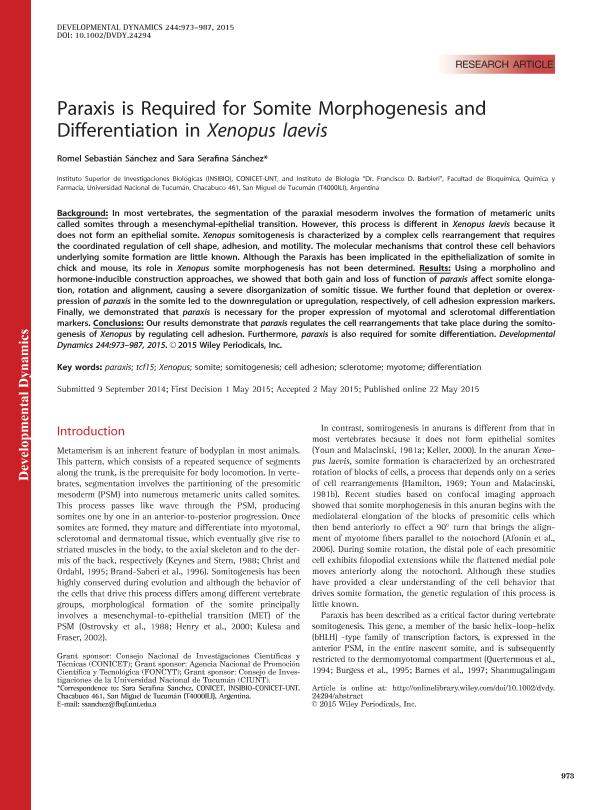Mostrar el registro sencillo del ítem
dc.contributor.author
Sanchez, Sara Serafina del V.

dc.contributor.author
Sanchez, Romel Sebastian

dc.date.available
2018-06-11T20:54:37Z
dc.date.issued
2015-08
dc.identifier.citation
Sanchez, Sara Serafina del V.; Sanchez, Romel Sebastian; Paraxis is required for somite morphogenesis and differentiation in Xenopus laevis; Wiley-liss, Div John Wiley & Sons Inc; Developmental Dynamics; 244; 8; 8-2015; 973-987
dc.identifier.issn
1058-8388
dc.identifier.uri
http://hdl.handle.net/11336/48190
dc.description.abstract
Background: In most vertebrates, the segmentation of the paraxial mesoderm involves the formation of metameric unitscalled somites through a mesenchymal-epithelial transition. However, this process is different in Xenopus laevis because itdoes not form an epithelial somite. Xenopus somitogenesis is characterized by a complex cells rearrangement that requiresthe coordinated regulation of cell shape, adhesion, and motility. The molecular mechanisms that control these cell behaviorsunderlying somite formation are little known. Although the Paraxis has been implicated in the epithelialization of somite inchick and mouse, its role in Xenopus somite morphogenesis has not been determined. Results: Using a morpholino andhormone-inducible construction approaches, we showed that both gain and loss of function of paraxis affect somite elongation,rotation and alignment, causing a severe disorganization of somitic tissue. We further found that depletion or overexpressionof paraxis in the somite led to the downregulation or upregulation, respectively, of cell adhesion expression markers.Finally, we demonstrated that paraxis is necessary for the proper expression of myotomal and sclerotomal differentiationmarkers. Conclusions: Our results demonstrate that paraxis regulates the cell rearrangements that take place during the somitogenesisof Xenopus by regulating cell adhesion. Furthermore, paraxis is also required for somite differentiation.
dc.format
application/pdf
dc.language.iso
eng
dc.publisher
Wiley-liss, Div John Wiley & Sons Inc

dc.rights
info:eu-repo/semantics/openAccess
dc.rights.uri
https://creativecommons.org/licenses/by-nc-sa/2.5/ar/
dc.subject
Xenopus
dc.subject
Somitogenesis
dc.subject
Paraxis
dc.subject.classification
Otras Ciencias Biológicas

dc.subject.classification
Ciencias Biológicas

dc.subject.classification
CIENCIAS NATURALES Y EXACTAS

dc.title
Paraxis is required for somite morphogenesis and differentiation in Xenopus laevis
dc.type
info:eu-repo/semantics/article
dc.type
info:ar-repo/semantics/artículo
dc.type
info:eu-repo/semantics/publishedVersion
dc.date.updated
2018-05-04T21:45:10Z
dc.journal.volume
244
dc.journal.number
8
dc.journal.pagination
973-987
dc.journal.pais
Estados Unidos

dc.journal.ciudad
Nueva York
dc.description.fil
Fil: Sanchez, Sara Serafina del V.. Consejo Nacional de Investigaciones Científicas y Técnicas. Centro Científico Tecnológico Conicet - Tucumán. Instituto Superior de Investigaciones Biológicas. Universidad Nacional de Tucumán. Instituto Superior de Investigaciones Biológicas; Argentina
dc.description.fil
Fil: Sanchez, Romel Sebastian. Consejo Nacional de Investigaciones Científicas y Técnicas. Centro Científico Tecnológico Conicet - Tucumán. Instituto Superior de Investigaciones Biológicas. Universidad Nacional de Tucumán. Instituto Superior de Investigaciones Biológicas; Argentina
dc.journal.title
Developmental Dynamics

dc.relation.alternativeid
info:eu-repo/semantics/altIdentifier/url/https://onlinelibrary.wiley.com/doi/epdf/10.1002/dvdy.24294
dc.relation.alternativeid
info:eu-repo/semantics/altIdentifier/doi/https://dx.doi.org/10.1002/DVDY.24294
Archivos asociados
